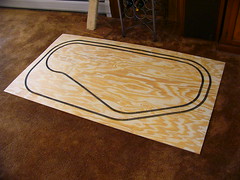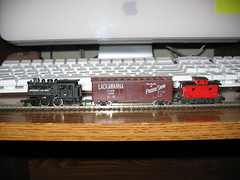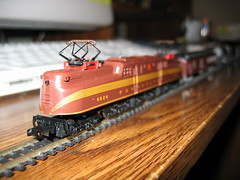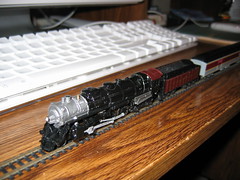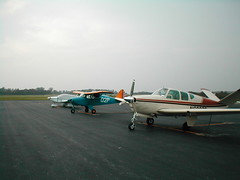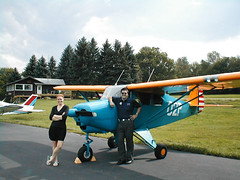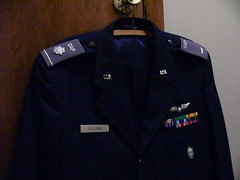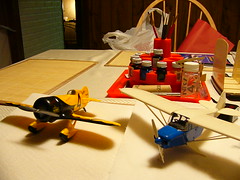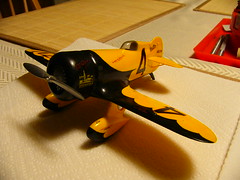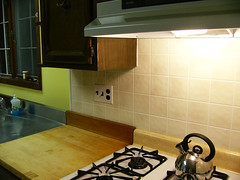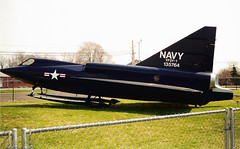David Lee Fielding
May 30, 1967 - December 18, 2005
Flight
Dave’s Logbook
My bumpy landing on the web
Monday, December 19, 2005
Saturday, December 10, 2005
I earn my wheels
Work is progressing on the "Fieldingville Railroad" - I found that with about 3/4 of my eBay track, I could make at least two ovals in the space available. I might still be able to make a siding and a small oval of trolley track yet.
But my mobility has been slipping; pain in my leg, hips and lower back has made it very painful to get about, or even up and down. This morning we filled the prescription for a wheelchair - I was worried it would be one of those giant, heavy chrome things, but it turned out to be rather elegant. Black and charcoal grey, and very narrow in action, fitted exactly to my size. But the morning was beautiful, rarely sunny and clear for December, and Gail suggested a short road trip; she read in one of my books about the Piper Museum in Lock Haven, PA - located at the old Piper factory where fabric-covered planes like the famous Cub and our own Tri-Pacer were built.
It was a great day for a drive, and we drove it - attended by beautiful winter skies like this. Gail took a small batch of photos - check out the very outgoing "museum cat"! (I have an album of photos of the Piper Aircraft Museum from June, when CAP buddy Alan and I flew down for "Sentimental Journey 2005", an annual fly-in at the old grass strip at Lock Haven.)
Beautiful sunsets on the way home provided a few more great landscapes, but we had to be content with the rearview mirror for the rich red and orange sunset - we were headed east! But at least I got to try out the wheelchair, and start building up my shoulder muscles... phew.
But my mobility has been slipping; pain in my leg, hips and lower back has made it very painful to get about, or even up and down. This morning we filled the prescription for a wheelchair - I was worried it would be one of those giant, heavy chrome things, but it turned out to be rather elegant. Black and charcoal grey, and very narrow in action, fitted exactly to my size. But the morning was beautiful, rarely sunny and clear for December, and Gail suggested a short road trip; she read in one of my books about the Piper Museum in Lock Haven, PA - located at the old Piper factory where fabric-covered planes like the famous Cub and our own Tri-Pacer were built.
It was a great day for a drive, and we drove it - attended by beautiful winter skies like this. Gail took a small batch of photos - check out the very outgoing "museum cat"! (I have an album of photos of the Piper Aircraft Museum from June, when CAP buddy Alan and I flew down for "Sentimental Journey 2005", an annual fly-in at the old grass strip at Lock Haven.)
Beautiful sunsets on the way home provided a few more great landscapes, but we had to be content with the rearview mirror for the rich red and orange sunset - we were headed east! But at least I got to try out the wheelchair, and start building up my shoulder muscles... phew.
Wednesday, December 07, 2005
Yet Another Disease
In this case a relapse of a condition I had as a child - I've come down with a case of Electric Trains. It is often overlooked as a harmless hobby, but the fact is that acquiring and operating model electric trains can become a mania, one that takes over lives and breaks families apart.
I exaggerate, of course. And I never actually got into it on a railfan level, or invested great sums of money in equipment. But when I was in grade school my mother let me indulge in a small N gauge layout (2-1/2' x 5') and a nice little collection of locomotives and rolling stock. (N gauge refers to the size, in this case one of the smallest; appropriate for apartment dwellers, as you can fit a longer track in a smaller space. HO is the most popular, twice the size of N; and O gauge are the large and very detailed trains, and the most expensive.)
When I went off to college, I sold my layout and about half of my trains with it. The ones that I really liked, like the hard-to-find trains and cars from our local area, I boxed and have kept stored for the last 20 years. Last week I took them out of storage, at first just to show Gail, but then I got fascinated all over again. I took a long piece of extra track from my workbench and taped it to my computer desk, and set about refurbishing my locomotives. The tiny gears and electric motors hadn't moved or been oiled for two decades, so it could have destroyed them to just put them back in service. I spent the next few days happily disassembling the locomotives, cleaning and lubricating the tiny mechanisms (one steam switcher engine is about 2 inches long!)
I got them all working again, including one that my long-departed uncle gave me, that never worked. Gail heard me across the room, zipping the little engines from one end of my desk to the other as I tested them. Well, that can only be fun for so long... I should really put up a simple oval of track and run them for a while. You know, just to keep them in good working order. I don't have any more track, but I bet I could find some cheap - on eBay! Yes, I went into the model train area on eBay, and yes, I found and purchased over 100 pieces of used track for a song. But I also found a zillion other electric train items, and I have browsed there endlessly since. (It's staggering to see how much people spend on this hobby; one perfectly-detailed O gauge train and coach set went for over $3,500!)
I also bid on and won a steam engine (for the much more modest sum of $37.98), a Pennsylvania Railroad K-4 "Pacific" that was built in larger numbers than any other train like it, back in the days when the PRR was the largest railroad in the world. I always wanted one to go with my set of Pennsy passenger coaches, even though I have a nice little GG-1 that works well with that train. The K-4 that I bought is an older model, well-used but serviceable, and even if the motor is bad I can replace it with a 5-pole motor that will run more smoothly at low speeds.
So now I have another project to keep me busy - I will scrounge up a piece of plywood, set it up next to the spare bed and nail down some of my eBay track in an oval or two. When I can't get around much, I can run my trains and hear the wheels click, and watch the drivers churning away on the old steam engines. Especially the pride of my old fleet, a Lackawanna Railroad "Hudson" heavy steam engine and a matching set of Lackawanna coaches, in handsome grey and maroon livery. Good clean fun.
I exaggerate, of course. And I never actually got into it on a railfan level, or invested great sums of money in equipment. But when I was in grade school my mother let me indulge in a small N gauge layout (2-1/2' x 5') and a nice little collection of locomotives and rolling stock. (N gauge refers to the size, in this case one of the smallest; appropriate for apartment dwellers, as you can fit a longer track in a smaller space. HO is the most popular, twice the size of N; and O gauge are the large and very detailed trains, and the most expensive.)
When I went off to college, I sold my layout and about half of my trains with it. The ones that I really liked, like the hard-to-find trains and cars from our local area, I boxed and have kept stored for the last 20 years. Last week I took them out of storage, at first just to show Gail, but then I got fascinated all over again. I took a long piece of extra track from my workbench and taped it to my computer desk, and set about refurbishing my locomotives. The tiny gears and electric motors hadn't moved or been oiled for two decades, so it could have destroyed them to just put them back in service. I spent the next few days happily disassembling the locomotives, cleaning and lubricating the tiny mechanisms (one steam switcher engine is about 2 inches long!)
I got them all working again, including one that my long-departed uncle gave me, that never worked. Gail heard me across the room, zipping the little engines from one end of my desk to the other as I tested them. Well, that can only be fun for so long... I should really put up a simple oval of track and run them for a while. You know, just to keep them in good working order. I don't have any more track, but I bet I could find some cheap - on eBay! Yes, I went into the model train area on eBay, and yes, I found and purchased over 100 pieces of used track for a song. But I also found a zillion other electric train items, and I have browsed there endlessly since. (It's staggering to see how much people spend on this hobby; one perfectly-detailed O gauge train and coach set went for over $3,500!)
I also bid on and won a steam engine (for the much more modest sum of $37.98), a Pennsylvania Railroad K-4 "Pacific" that was built in larger numbers than any other train like it, back in the days when the PRR was the largest railroad in the world. I always wanted one to go with my set of Pennsy passenger coaches, even though I have a nice little GG-1 that works well with that train. The K-4 that I bought is an older model, well-used but serviceable, and even if the motor is bad I can replace it with a 5-pole motor that will run more smoothly at low speeds.
So now I have another project to keep me busy - I will scrounge up a piece of plywood, set it up next to the spare bed and nail down some of my eBay track in an oval or two. When I can't get around much, I can run my trains and hear the wheels click, and watch the drivers churning away on the old steam engines. Especially the pride of my old fleet, a Lackawanna Railroad "Hudson" heavy steam engine and a matching set of Lackawanna coaches, in handsome grey and maroon livery. Good clean fun.
Status Report
I guess I haven't posted a thorough update for a while, since I'm getting a lot of other inquiries; it's no bother, nice to know that I have such concerned friends and family. Everyone seems afraid to disturb me, but I appreciate hearing from you; if I'm too sick to answer a phone call or email, I will get back to you when I can.
I have been on the new chemotherapy program since last Tuesday, and have been tolerating it fairly well. It involves a switch back to the platinum-based drug that I started with back in August, but at that time I was taking another drug at the same time. The combination or dosage made me very ill, right before the wedding unfortunately. This time around I seem to be retaining my appetite and health in general, even though the schedule calls for a massive dose every two weeks. My next chemo treatment will be Thursday the 15th.
I've written about the troubles with my blood counts; the three that seem to concern the doctors the most are hemoglobin, white blood cells and platelets. We spent two weeks juggling drugs and shots to try to stimulate my bone marrow, which is crucial in the production of new blood. The radiation treatments were suspended for this time, which is the Catch-22: if we treat aggressively with radiation, it will interfere with my bone marrow. But so does the cancer; it has retreated into my bones, where the chemotherapy takes the longest to penetrate.
While off the radiation, the cancer that we were treating - in my right hip - has grown worse, and I have developed at least two new tumors above and below my right knee. Since this past Sunday, the increase in pain has made me almost lame; Gail has had to lift me out of bed several times, and support me while I stagger just to get to the bathroom. For the last two days I've only been able to keep going with my cane by taking a much larger dosage of my primary pain medication, oxycodone, and other drugs. Tuesday night I overmedicated and had some scary secondary symptoms.
The best news this week is that we finally got all three blood counts into the acceptable ranges, and the radiation treatments will resume tomorrow. We had one plan in place for my lower back/pelvic area, and a new one is being designed for my leg. These targeted treatments have proven effective in the past; we cured my left hip, left shoulder and neck this way. I have hopes that the new treatments will be as effective on my right leg, and let me be mobile again. In other good news, my weight is back up to 180 lbs, from a nadir of 171 (and a pre-cancer weight of 230). They did notice that my calcium levels are up, which I guess might be from all the Boosts and Ensures that I've been drinking, not to mention lots of milk and pudding. High calcium is not necessarily good news; it can mean that the calcium is not getting absorbed by the bones, and getting stored in the bloodstream. This can lead to other troubles like kidney stones and bone spurs.
That's the nuts and bolts of it. In general, I'm in good spirits, mainly due to my amazing wife; she looks after me physically, emotionally and nutritionally. And of course to all of my friends and family, who have all been a great support and comfort. Unable to walk or stand much, I've been keeping myself distracted with books and the internet, and with working with my hands; the model kits that I mentioned in an earlier post, and another new project that I will relate in the next.
Thank you all, and especially Gail, for your patience and love. Status Report: Hangin' in there.
I have been on the new chemotherapy program since last Tuesday, and have been tolerating it fairly well. It involves a switch back to the platinum-based drug that I started with back in August, but at that time I was taking another drug at the same time. The combination or dosage made me very ill, right before the wedding unfortunately. This time around I seem to be retaining my appetite and health in general, even though the schedule calls for a massive dose every two weeks. My next chemo treatment will be Thursday the 15th.
I've written about the troubles with my blood counts; the three that seem to concern the doctors the most are hemoglobin, white blood cells and platelets. We spent two weeks juggling drugs and shots to try to stimulate my bone marrow, which is crucial in the production of new blood. The radiation treatments were suspended for this time, which is the Catch-22: if we treat aggressively with radiation, it will interfere with my bone marrow. But so does the cancer; it has retreated into my bones, where the chemotherapy takes the longest to penetrate.
While off the radiation, the cancer that we were treating - in my right hip - has grown worse, and I have developed at least two new tumors above and below my right knee. Since this past Sunday, the increase in pain has made me almost lame; Gail has had to lift me out of bed several times, and support me while I stagger just to get to the bathroom. For the last two days I've only been able to keep going with my cane by taking a much larger dosage of my primary pain medication, oxycodone, and other drugs. Tuesday night I overmedicated and had some scary secondary symptoms.
The best news this week is that we finally got all three blood counts into the acceptable ranges, and the radiation treatments will resume tomorrow. We had one plan in place for my lower back/pelvic area, and a new one is being designed for my leg. These targeted treatments have proven effective in the past; we cured my left hip, left shoulder and neck this way. I have hopes that the new treatments will be as effective on my right leg, and let me be mobile again. In other good news, my weight is back up to 180 lbs, from a nadir of 171 (and a pre-cancer weight of 230). They did notice that my calcium levels are up, which I guess might be from all the Boosts and Ensures that I've been drinking, not to mention lots of milk and pudding. High calcium is not necessarily good news; it can mean that the calcium is not getting absorbed by the bones, and getting stored in the bloodstream. This can lead to other troubles like kidney stones and bone spurs.
That's the nuts and bolts of it. In general, I'm in good spirits, mainly due to my amazing wife; she looks after me physically, emotionally and nutritionally. And of course to all of my friends and family, who have all been a great support and comfort. Unable to walk or stand much, I've been keeping myself distracted with books and the internet, and with working with my hands; the model kits that I mentioned in an earlier post, and another new project that I will relate in the next.
Thank you all, and especially Gail, for your patience and love. Status Report: Hangin' in there.
Sunday, December 04, 2005
Movie Review: "City of God" (Cidade de Deus)
Gail picked this Brazilian film for our Netflix queue, based on its success at the Toronto film festival and other accolades; and I'm sure she was intrigued by the narrator/protagonist, who is a photographer of sorts. The title refers to a government-created area of low-income housing in Rio de Janeiro; a favela, or slum at the time of the story (1960s - late 1970s). The wealthy citizens and luxury hotels of Rio cannot brook living alongside the urban poor, so they are herded into a sprawling shanty community with little or no amenities, social services or police protection. Inevitably the ghetto becomes a place of desperation, massive drug trafficking and violent crime - even small children go armed with handguns, and lives are lost seemingly every hour of the day.
In this frightening place lives Busca-Pé (nicknamed "Rocket") a young boy who has no wish to be a thug or criminal, nor to toil away at menial work that will never lift him from poverty. He finds that he has a natural eye for photography and begins to document the world around him; but the violence is so pervasive that it allows virtually no hope of being anything but criminal or victim.
The film wasn't exactly what we anticipated; it is overwhelmingly brutal, difficult to watch at times, although artfully shot and edited. The pace is relentless and the bullets fly; no one is spared, no place is safe, which may be the central theme. Finer emotions and motivations are hardly present, including Rocket's pursuit of photography - various gangs of thugs struggle for power, guns and drugs. In a fascinating hour-long DVD extra, the truth of the favelas is revealed through interviews and news clips; the movie, though based on a novel, is an accurate picture of this cruel place.
I couldn't watch it again, but it does offer an honest portrayal of human predation and violence; the depths of cruelty that hopelessness and poverty can breed. (And on an odd note, the characters in the movie have some truly great nicknames: Li'l Zé, Shaggy, Carrot, Knockout Ned, Clipper...)
In this frightening place lives Busca-Pé (nicknamed "Rocket") a young boy who has no wish to be a thug or criminal, nor to toil away at menial work that will never lift him from poverty. He finds that he has a natural eye for photography and begins to document the world around him; but the violence is so pervasive that it allows virtually no hope of being anything but criminal or victim.
The film wasn't exactly what we anticipated; it is overwhelmingly brutal, difficult to watch at times, although artfully shot and edited. The pace is relentless and the bullets fly; no one is spared, no place is safe, which may be the central theme. Finer emotions and motivations are hardly present, including Rocket's pursuit of photography - various gangs of thugs struggle for power, guns and drugs. In a fascinating hour-long DVD extra, the truth of the favelas is revealed through interviews and news clips; the movie, though based on a novel, is an accurate picture of this cruel place.
I couldn't watch it again, but it does offer an honest portrayal of human predation and violence; the depths of cruelty that hopelessness and poverty can breed. (And on an odd note, the characters in the movie have some truly great nicknames: Li'l Zé, Shaggy, Carrot, Knockout Ned, Clipper...)
Saturday, December 03, 2005
The Saga of 02P, Part IV
I left this story with Karen and I landed at the Parkersburg, WV airport. We parked 02P among the sleek white airplanes on the private ramp, her exhaust pipes pinging as they cooled. The sun was setting, the weather was just easing out of hot and muggy into a damp evening cool, and we were at a good-sized and modern little airport - one that was completely deserted. The snack counter was closed, the big waiting areas and gate were devoid of people; we began to wonder if there was a soul around besides us. We did come across a line guy in the FBO, chatting with a woman who turned out to be the only other person on the premises - apparently, they fold Parkersburg up and put it away early!
We asked about cheap hotels nearby, and began to skim the phone book and call around. Karen, having lived the airport-hopping life for so long (as both flight attendant and co-pilot) has a mania for finding THE cheapest hotel, and took to the task with relish. I found one for $44.00, but she dug up another that was only $38.00! We were still far enough south for Southern Hospitality, and the line guy offered to drive us out to the hotel, even though it was almost 20 minutes away - 20 long minutes, weaving up into quiet West Virginia foothills.
The motel was a shambles, well-worn and sunbaked, with cracked pavement and broken glass everywhere; the kind of place where everything was bolted down. As we walked to the office, some of the room doors hung open, and the sounds of small celebrations and domestic arguments drifted around. We checked in and picked up some cold sodas, and back at Karen's room we giggled over the sheer awfulness of the place. (And Karen advised me to peel back the slipcover from my bed as she did, and shared some other sanitary advice fitting for No-Tell Motels.) In my room, I stretched out and tried to shake off the day's adventures and worries. I was concerned about the condition of the plane, for one thing; the overheating problem, and the high oil consumption could indicate expensive problems. And I hoped that the weather would improve; the next day's forecast was iffy, with low ceilings and a chance of rain. I didn't want to have Karen miss any of her flights - she and Sal both work for the airlines, and with two toddlers their weekly schedule is carefully planned.
The next morning we called a cab to take us back to the airport, but it looked like we were going to have to wait for the weather anyway. Fog and haze, and not a breath of wind; nothing to do but wait to see if it burned off in the sun. Finally after 10:30 or so we decided that we had the mandatory 1,000 feet (maybe 950) and boarded the plane. We climbed up until we bumped our heads on the ceiling, and skimmed along that way for a while, just managing to keep good visibility - where there weren't clouds, there was thick summer haze, and navigation would have been a challenge if we hadn't had the little GPS unit. Things went well until we got into Pennsylvania again, and the clouds started to get lower and more uneven. I began looking for an alternate, and we decided to land for a while at Allegheny County airport near Pittsburgh; I'd been there many times, they have a big C.A.P. squadron and a nice old terminal.
As we neared the airport, we were in communication with the tower, and we were truly "scud-running" - weaving around the clouds, trying to stay visual, since we weren't filed or equipped for blind flight. A Bad Idea. We actually had to make use of a river valley to make the airport area, figuring that if I kept over the river I wouldn't clip a mountaintop. Then we got a traffic report from Allegheny County, it seemed that another aircraft was using the same dodge I was...
"Tri-Pacer 02P, traffic at your 1:00 and two miles, blimp."
"Ahhh, roger, Tri-Pacer looking..."
And sure enough, there drifted into view the ample hindquarters of the Goodyear Blimp, dead ahead! I passed around the big ellipsoid (at least I can outrun some things in the air!) and beat them to the airport; the crew of the blimp was seeking refuge from the weather too. We taxied to the ramp, and the controller paid me the first compliment I was to get on the merry paint scheme of my plane; the first of many since then. We parked near the flight school, and had an audience of grounded students. They were marveling at the odd collection of refugees brought to earth by the fading weather: first a crazy little blue-and-yellow Tri-Pacer, then the mooring crew racing out to meet the Goodyear blimp, then a local TV helicopter. While we waited out the weather for 90 minutes or so, I chatted with a little boy and his grandmother who had come out to watch airplanes, and I couldn't resist taking him out onto the ramp and letting him climb into 02P; the first of many tours since then.
We staked out the weather station at the flight school and waited for acceptable conditions, and eventually decided we could try the next leg; I would bend our course to the north and try to make use of Pennsylvania's corduroy geography, flying parallel up the glacial valleys to get us back to the northeast. Central Pennsylvania was referred to as the "Hell Stretch" by the airmail pilots of the 1920s, just for this reason; lowering clouds and mountains can combine to make a deadly maze. But as we crossed the state, conditions were improving, and the plane was running better too; oil temp and use went back to normal, and we were able to climb a bit for better fuel consumption. Our northernly course took us over Lock Haven, the ancestral home of the Tri-Pacer and thousands of other little ragwing Pipers; so I flew directly over the old Piper factory, today only a rural airport and the neat little Piper Museum.
Finally we were back in our home radar service, and I contacted the Wilkes-Barre/Scranton controller. We had made the last two legs into one, thanks to the reduced fuel burn, and we headed across Scranton and up to Cherry Ridge. Karen was able to contact Sal on the way in, and he and their little twin boys were there to meet us - "We want to see the circus plane!" The day was sunny by now, and we took some pictures, and let out a huge sigh of relief. I wasn't done flying for the day, though; I had to collect my car from the Wilkes-Barre/Scranton airport. So I arranged for my mother and my squadron CO Les to meet me down there; Les would drive my car back for me, and Mom got her first ride in the plane, back to Cherry Ridge.
It had been a long, hot, challenging journey across 850 miles... but here finally was my plane, in my hangar. Whew!
We asked about cheap hotels nearby, and began to skim the phone book and call around. Karen, having lived the airport-hopping life for so long (as both flight attendant and co-pilot) has a mania for finding THE cheapest hotel, and took to the task with relish. I found one for $44.00, but she dug up another that was only $38.00! We were still far enough south for Southern Hospitality, and the line guy offered to drive us out to the hotel, even though it was almost 20 minutes away - 20 long minutes, weaving up into quiet West Virginia foothills.
The motel was a shambles, well-worn and sunbaked, with cracked pavement and broken glass everywhere; the kind of place where everything was bolted down. As we walked to the office, some of the room doors hung open, and the sounds of small celebrations and domestic arguments drifted around. We checked in and picked up some cold sodas, and back at Karen's room we giggled over the sheer awfulness of the place. (And Karen advised me to peel back the slipcover from my bed as she did, and shared some other sanitary advice fitting for No-Tell Motels.) In my room, I stretched out and tried to shake off the day's adventures and worries. I was concerned about the condition of the plane, for one thing; the overheating problem, and the high oil consumption could indicate expensive problems. And I hoped that the weather would improve; the next day's forecast was iffy, with low ceilings and a chance of rain. I didn't want to have Karen miss any of her flights - she and Sal both work for the airlines, and with two toddlers their weekly schedule is carefully planned.
The next morning we called a cab to take us back to the airport, but it looked like we were going to have to wait for the weather anyway. Fog and haze, and not a breath of wind; nothing to do but wait to see if it burned off in the sun. Finally after 10:30 or so we decided that we had the mandatory 1,000 feet (maybe 950) and boarded the plane. We climbed up until we bumped our heads on the ceiling, and skimmed along that way for a while, just managing to keep good visibility - where there weren't clouds, there was thick summer haze, and navigation would have been a challenge if we hadn't had the little GPS unit. Things went well until we got into Pennsylvania again, and the clouds started to get lower and more uneven. I began looking for an alternate, and we decided to land for a while at Allegheny County airport near Pittsburgh; I'd been there many times, they have a big C.A.P. squadron and a nice old terminal.
As we neared the airport, we were in communication with the tower, and we were truly "scud-running" - weaving around the clouds, trying to stay visual, since we weren't filed or equipped for blind flight. A Bad Idea. We actually had to make use of a river valley to make the airport area, figuring that if I kept over the river I wouldn't clip a mountaintop. Then we got a traffic report from Allegheny County, it seemed that another aircraft was using the same dodge I was...
"Tri-Pacer 02P, traffic at your 1:00 and two miles, blimp."
"Ahhh, roger, Tri-Pacer looking..."
And sure enough, there drifted into view the ample hindquarters of the Goodyear Blimp, dead ahead! I passed around the big ellipsoid (at least I can outrun some things in the air!) and beat them to the airport; the crew of the blimp was seeking refuge from the weather too. We taxied to the ramp, and the controller paid me the first compliment I was to get on the merry paint scheme of my plane; the first of many since then. We parked near the flight school, and had an audience of grounded students. They were marveling at the odd collection of refugees brought to earth by the fading weather: first a crazy little blue-and-yellow Tri-Pacer, then the mooring crew racing out to meet the Goodyear blimp, then a local TV helicopter. While we waited out the weather for 90 minutes or so, I chatted with a little boy and his grandmother who had come out to watch airplanes, and I couldn't resist taking him out onto the ramp and letting him climb into 02P; the first of many tours since then.
We staked out the weather station at the flight school and waited for acceptable conditions, and eventually decided we could try the next leg; I would bend our course to the north and try to make use of Pennsylvania's corduroy geography, flying parallel up the glacial valleys to get us back to the northeast. Central Pennsylvania was referred to as the "Hell Stretch" by the airmail pilots of the 1920s, just for this reason; lowering clouds and mountains can combine to make a deadly maze. But as we crossed the state, conditions were improving, and the plane was running better too; oil temp and use went back to normal, and we were able to climb a bit for better fuel consumption. Our northernly course took us over Lock Haven, the ancestral home of the Tri-Pacer and thousands of other little ragwing Pipers; so I flew directly over the old Piper factory, today only a rural airport and the neat little Piper Museum.
Finally we were back in our home radar service, and I contacted the Wilkes-Barre/Scranton controller. We had made the last two legs into one, thanks to the reduced fuel burn, and we headed across Scranton and up to Cherry Ridge. Karen was able to contact Sal on the way in, and he and their little twin boys were there to meet us - "We want to see the circus plane!" The day was sunny by now, and we took some pictures, and let out a huge sigh of relief. I wasn't done flying for the day, though; I had to collect my car from the Wilkes-Barre/Scranton airport. So I arranged for my mother and my squadron CO Les to meet me down there; Les would drive my car back for me, and Mom got her first ride in the plane, back to Cherry Ridge.
It had been a long, hot, challenging journey across 850 miles... but here finally was my plane, in my hangar. Whew!
Tuesday, November 29, 2005
Name, Rank and Medical Report
It's been a busy day, lots to talk about. It began at the oncology office, where we discussed the dilemma of my health. Yesterday's bloodwork showed that my hemoglobin and platelet counts are still very low; so much so that the radiologist feels that it's too dangerous to keep me on chemo and radiation together. The X-ray from last week showed that the cancer has spread into the two long bones in my right leg, interfering with the bone marrow and causing me considerable pain.
The trouble is that we have to get my blood counts up, or I will get sicker. The radiation will lower the blood counts even further, and the chemotherapy carries its own side effects that may put me in bed too. But untreated, the cancer can (and has) spread. So we agreed that it would be better to go down fighting than to hope that the blood counts will come up on their own. So I started this afternoon on a stronger dose of another chemotherapy drug, the one I was first given after my diagnosis; it brought me a lot of nausea and other nasty side effects, but Dr. A feels that it is our best hope.
The thing is, I feel fairly well. The worst of it for the past five days has been that the bone pain has been growing somewhat, forcing me to take supplemental pain medication during the day; but with careful dosage, and taking food along with the pills, I have avoided the worst of the stomach damage.
I had a long chemotherapy session, then got typed and matched for another transfusion tomorrow; I am to get two more units of whole blood and two of platelets. All week I am also getting various injections to try and help my remaining bone marrow work overtime to manufacture some blood. Think - er - bloody thoughts everyone!
Then I just made it home in time to meet one of my squadron pilots, who drove me out to headquarters for our Civil Air Patrol meeting. My deputy commander had asked me to come out if I could manage, as they had a "special" presentation to make, and that the Wing Commander might be there. I assumed that it was my long, long deferred promotion to Captain; since rank is of little consequence in the CAP, I never really bothered to put through the paperwork, even though I could have done so years ago. I had a good five-year run as First Lieutenant, and always kidded that I never wanted to be a Major - too likely to end up on a committee, instead of in a cockpit!
It turns out that the surprise was indeed that - the Wing Commander couldn't make it, but the Group Commander called me forward and read off a list of my accolades over the last eight years; what's left of my blood managed to turn my ears a bit red for the occasion, and I blushed. He also recognized 207 as the premiere squadron in Group 4, the biggest and most well-trained unit in eastern Pennsylvania. Then he announced to the formation present that I was being given a merit promotion to the rank of Lieutenant Colonel. That's passing over Captain AND Major! As I said, rank in the CAP is largely ceremonial; since we are all unpaid volunteers, it's not like my salary is going up! But I was bowled over, and flattered, and I hardly knew what to say. I managed to stammer out a few words and thanked my squadron for their tremendous support and hard work.
It has been my pride and honor to serve my squadron since 1997, for the last nine months as Squadron Commander. I've spent hundreds of hours in training, flying, and working with a great group of officers and teenage cadets; plus I've gotten USAF travel opportunities, furthered my own flying career and been honored with a national award for education. I hope that I will soon recover my health, and become active again with the organization - and make some real trouble with these silver clusters! Thanks again to those who have made my volunteering so rewarding.
The trouble is that we have to get my blood counts up, or I will get sicker. The radiation will lower the blood counts even further, and the chemotherapy carries its own side effects that may put me in bed too. But untreated, the cancer can (and has) spread. So we agreed that it would be better to go down fighting than to hope that the blood counts will come up on their own. So I started this afternoon on a stronger dose of another chemotherapy drug, the one I was first given after my diagnosis; it brought me a lot of nausea and other nasty side effects, but Dr. A feels that it is our best hope.
The thing is, I feel fairly well. The worst of it for the past five days has been that the bone pain has been growing somewhat, forcing me to take supplemental pain medication during the day; but with careful dosage, and taking food along with the pills, I have avoided the worst of the stomach damage.
I had a long chemotherapy session, then got typed and matched for another transfusion tomorrow; I am to get two more units of whole blood and two of platelets. All week I am also getting various injections to try and help my remaining bone marrow work overtime to manufacture some blood. Think - er - bloody thoughts everyone!
Then I just made it home in time to meet one of my squadron pilots, who drove me out to headquarters for our Civil Air Patrol meeting. My deputy commander had asked me to come out if I could manage, as they had a "special" presentation to make, and that the Wing Commander might be there. I assumed that it was my long, long deferred promotion to Captain; since rank is of little consequence in the CAP, I never really bothered to put through the paperwork, even though I could have done so years ago. I had a good five-year run as First Lieutenant, and always kidded that I never wanted to be a Major - too likely to end up on a committee, instead of in a cockpit!
It turns out that the surprise was indeed that - the Wing Commander couldn't make it, but the Group Commander called me forward and read off a list of my accolades over the last eight years; what's left of my blood managed to turn my ears a bit red for the occasion, and I blushed. He also recognized 207 as the premiere squadron in Group 4, the biggest and most well-trained unit in eastern Pennsylvania. Then he announced to the formation present that I was being given a merit promotion to the rank of Lieutenant Colonel. That's passing over Captain AND Major! As I said, rank in the CAP is largely ceremonial; since we are all unpaid volunteers, it's not like my salary is going up! But I was bowled over, and flattered, and I hardly knew what to say. I managed to stammer out a few words and thanked my squadron for their tremendous support and hard work.
It has been my pride and honor to serve my squadron since 1997, for the last nine months as Squadron Commander. I've spent hundreds of hours in training, flying, and working with a great group of officers and teenage cadets; plus I've gotten USAF travel opportunities, furthered my own flying career and been honored with a national award for education. I hope that I will soon recover my health, and become active again with the organization - and make some real trouble with these silver clusters! Thanks again to those who have made my volunteering so rewarding.
Hobby Time
My hands seemed to be steadier tonight, so I pulled out the model Tri-Pacer that I started a few months ago. I also unearthed another model that I found in the basement, a model racing plane that I had nearly finished from years ago - I must have set it aside sometime around 1992, when my former brother-in-law got me started with the bigger radio-controlled flying models. This poor kit only needed the last few scallops painted on its jaunty 1930s paint scheme, and a few odd parts glued on. I've dusted it off and hand-painted the last details, and with a coat of gloss enamel and a few flying wires it will be ready for the shelf.
It's a replica of the 1931 Gee Bee Model Z, a classic from the glory days of air racing. The Gee Bees (named for the New England company that built them, the Granville Brothers) were notorious for their approach to speed-seeking: maximum engine, minimum airplane. The stubby Model Z was only 15 feet long, but was bolted to a 535 h.p. "Wasp Junior" radial engine, loaned to the brothers by the Pratt & Whitney company for "testing". The combination was a handful to fly, but it was certainly fast; ex-barnstormer Lowell Bayles flew it to an easy win in the 1931 Thompson Trophy at 236 m.p.h.
But ambition seized the Granvilles and Pratt & Whitney, and the engine was changed out for an even bigger 750 h.p. Wasp Senior - in this form, Bayles could hardly see around the cowl! But an attempt was set up to try for the world speed record, 278 m.p.h., held by the French. The first set of straight-line runs averaged 281 m.p.h., good enough for the U.S. record, but not enough to better the world mark by a wide enough margin. The next time out, Bayles entered the timing run at over 300 m.p.h... but then cameras captured a gruesome sight as a wing panel snapped off, and the tiny Gee Bee rolled into the ground. Bayles and the plane were destroyed in an instant.
The Granvilles built other racers; their 1932 Model R won both the Thompson Trophy (with Jimmy Doolittle flying) and the transcontinental Bendix Trophy. But the whole family of planes were just like the Z, fast and capricious - and some less-experienced pilots were killed trying to pilot the "flying barrels" in other events. I've always been fascinated by them; the colorful scalloped paint schemes were a Granville Brothers trademark, and have come to be iconic of the whole pylon racing era. Many of these little planes were built in small hangars and garages during the Depression, with limited resources and engineering; but they contributed a lot to the advancement of aviation technology.
It's a replica of the 1931 Gee Bee Model Z, a classic from the glory days of air racing. The Gee Bees (named for the New England company that built them, the Granville Brothers) were notorious for their approach to speed-seeking: maximum engine, minimum airplane. The stubby Model Z was only 15 feet long, but was bolted to a 535 h.p. "Wasp Junior" radial engine, loaned to the brothers by the Pratt & Whitney company for "testing". The combination was a handful to fly, but it was certainly fast; ex-barnstormer Lowell Bayles flew it to an easy win in the 1931 Thompson Trophy at 236 m.p.h.
But ambition seized the Granvilles and Pratt & Whitney, and the engine was changed out for an even bigger 750 h.p. Wasp Senior - in this form, Bayles could hardly see around the cowl! But an attempt was set up to try for the world speed record, 278 m.p.h., held by the French. The first set of straight-line runs averaged 281 m.p.h., good enough for the U.S. record, but not enough to better the world mark by a wide enough margin. The next time out, Bayles entered the timing run at over 300 m.p.h... but then cameras captured a gruesome sight as a wing panel snapped off, and the tiny Gee Bee rolled into the ground. Bayles and the plane were destroyed in an instant.
The Granvilles built other racers; their 1932 Model R won both the Thompson Trophy (with Jimmy Doolittle flying) and the transcontinental Bendix Trophy. But the whole family of planes were just like the Z, fast and capricious - and some less-experienced pilots were killed trying to pilot the "flying barrels" in other events. I've always been fascinated by them; the colorful scalloped paint schemes were a Granville Brothers trademark, and have come to be iconic of the whole pylon racing era. Many of these little planes were built in small hangars and garages during the Depression, with limited resources and engineering; but they contributed a lot to the advancement of aviation technology.
Wednesday, November 23, 2005
Maple-brine Turkey
I seem to have piqued some curiosity about my Thanksgiving turkey recipe. "Brining" is simply marinating in salt water, which penetrates the meat well. This brine uses maple syrup and brown sugar; but it doesn't make the turkey salty, or overpower the flavor. It adds a subtle sweet flavor to the outer skin, and I find that it keeps the meat very moist; no dry turkey!
INGREDIENTS:
1-1/2 gallons (24 cups) water
1-1/2 cups maple syrup
1 cup salt
3/4 cup brown sugar
Mix all this up in a big stockpot at room temperature, plop in your turkey, and stick it in the 'fridge for 12-24 hours before cooking. (Discard the brine afterwards.) I use 325 degrees for three hours, for my usual 9-10 pound turkey; follow the directions for other sizes. I use a baking bag, and open it up for the last hour to crisp the skin. So far I've gotten a nice juicy bird every time.
Happy Thanksgiving!
INGREDIENTS:
1-1/2 gallons (24 cups) water
1-1/2 cups maple syrup
1 cup salt
3/4 cup brown sugar
Mix all this up in a big stockpot at room temperature, plop in your turkey, and stick it in the 'fridge for 12-24 hours before cooking. (Discard the brine afterwards.) I use 325 degrees for three hours, for my usual 9-10 pound turkey; follow the directions for other sizes. I use a baking bag, and open it up for the last hour to crisp the skin. So far I've gotten a nice juicy bird every time.
Happy Thanksgiving!
Weird Planes
Since I have a lot of time on my hands, in waiting rooms and otherwise, I've been reading a lot. I've worked through almost everything in my vast aviation and science-fiction library that I care to re-read, and so I ordered some new books for myself. I have always loved bookstores; when I was a kid, I would head straight for the bookstore, stay there for hours and grumble if I had to do any other shopping. But now it's all online - Barnes & Noble, Amazon and others all have smooth-working websites that let you browse inside the book covers a little. And there are plenty of smaller stores online too, with specialized subject matter, like Hannan's Runway - for modelers and other airplane enthusiasts.
I have two new books from Hannan's, monographs on a few obscure planes from the 1950s. It was the era when the Cold War got into full swing, and the superpowers let the military aviation budgets run wild, with some startling results. It seems as though just about any cockamamie idea was worth a few zillion dollars and a few prototypes; of course, in those days without computer simulation, that was the only way to find out whether theory could be put into practice. Aviation history of this era is dotted with faded pictures of these orphans, hilarious in hindsight to everyone but the poor test pilots - where they survived...
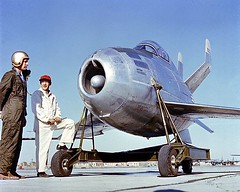 For example, jet bombers of that era had much longer range than jet fighters. But bombers are vulnerable without fighter escort. Proposal: Stick a tiny, ugly jet fighter inside the bomber. When the bomber is attacked, release it on a trapeze and let it go off to battle the Commies. Then the jet fighter returns to the bomber IN MIDAIR, latches on again, FOLDS UP and is pulled in. Insane, right? But they did it - this is the XF-85 "Goblin", built to test the "parasite fighter" concept. Its bizarre shape allowed it to fit into the bomb bay of a B-29, but left it severely limited in terms of performance and stability.
For example, jet bombers of that era had much longer range than jet fighters. But bombers are vulnerable without fighter escort. Proposal: Stick a tiny, ugly jet fighter inside the bomber. When the bomber is attacked, release it on a trapeze and let it go off to battle the Commies. Then the jet fighter returns to the bomber IN MIDAIR, latches on again, FOLDS UP and is pulled in. Insane, right? But they did it - this is the XF-85 "Goblin", built to test the "parasite fighter" concept. Its bizarre shape allowed it to fit into the bomb bay of a B-29, but left it severely limited in terms of performance and stability.
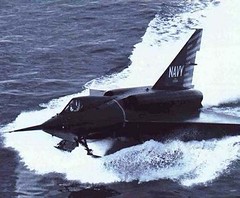 One of my new books details the Convair Sea Dart, a supersonic jet fighter... seaplane. The U.S. Navy opined that runways and air bases were expensive to build and maintain, and even Air Force pilots could land on them. So the "floating base" concept was put forward whereby bombers, cargo planes and even the fighters could land and take off on water, bobbing happily away in any harbor or lake. The Sea Dart - a twin-jet, delta-winged fighter was designed to take off and land ON WATERSKIS - insane, right? But five were built and three actually flown - and they remain, to this day, the only supersonic seaplanes ever built. (The test planes were underpowered, but one of them exceeded the speed of sound in a slight dive.)
One of my new books details the Convair Sea Dart, a supersonic jet fighter... seaplane. The U.S. Navy opined that runways and air bases were expensive to build and maintain, and even Air Force pilots could land on them. So the "floating base" concept was put forward whereby bombers, cargo planes and even the fighters could land and take off on water, bobbing happily away in any harbor or lake. The Sea Dart - a twin-jet, delta-winged fighter was designed to take off and land ON WATERSKIS - insane, right? But five were built and three actually flown - and they remain, to this day, the only supersonic seaplanes ever built. (The test planes were underpowered, but one of them exceeded the speed of sound in a slight dive.)
As you might guess, they were useless as fighter planes, and practically destroyed themselves on takeoff and landing. I have actually seen two of the surviving examples, this one on display at Willow Grove Naval Air Station near Philadelphia, the other at a museum in San Diego. (Oddly, I saw them on two consecutive days, when I flew out with the Air Force!)
Amazing, that so much money and effort was put into projects like these, with so little return on the investment. Especially in those cases, like the Sea Dart, where test pilots were killed in the flight-test program. But then, the mixture of comedy and tragedy in these machines seems appropriate for the whole Cold War, doesn't it?
I have two new books from Hannan's, monographs on a few obscure planes from the 1950s. It was the era when the Cold War got into full swing, and the superpowers let the military aviation budgets run wild, with some startling results. It seems as though just about any cockamamie idea was worth a few zillion dollars and a few prototypes; of course, in those days without computer simulation, that was the only way to find out whether theory could be put into practice. Aviation history of this era is dotted with faded pictures of these orphans, hilarious in hindsight to everyone but the poor test pilots - where they survived...


As you might guess, they were useless as fighter planes, and practically destroyed themselves on takeoff and landing. I have actually seen two of the surviving examples, this one on display at Willow Grove Naval Air Station near Philadelphia, the other at a museum in San Diego. (Oddly, I saw them on two consecutive days, when I flew out with the Air Force!)
Amazing, that so much money and effort was put into projects like these, with so little return on the investment. Especially in those cases, like the Sea Dart, where test pilots were killed in the flight-test program. But then, the mixture of comedy and tragedy in these machines seems appropriate for the whole Cold War, doesn't it?
Setbacks
After getting a few extra days off from radiation, I still tested with very low blood counts on Monday. I had my radiation treatments, but with the counts still low on Tuesday my oncologist decided to postpone my chemotherapy. The problem is that the radiation and chemotherapy both affect my bone marrow, so that it doesn't produce the right blood cells - but the cancer itself is also having the same effect. Some new painful areas, and the evidence of the blood count, indicate that the cancer is working on my bone marrow too.
Oddly, I don't feel that much worse than I have been for the last month. I still have to take painkillers around the clock, and I've had terrible digestive tract problems; but my appetite and energy have been reasonably consistent. But on Monday they asked me to report in immediately if I experienced any fevers (because I have few white blood cells to fight infections) or bleeding (because I have few platelets to coagulate my blood). Well, lo and behold Tuesday morning I developed a spontaneous nosebleed, and Gail took me in early to Dr. A's office. He discussed the predicament that we're in; do we press harder with chemotherapy and radiation, which may leave me bedridden, or back off and risk further damage from the cancer? It's a balancing act between quality of life and quantity, only now with a narrower margin than we have had so far.
So the plan for the coming week is to continue my radiation treatments Wednesday, since I am almost done with the neck-shoulder series, and there is little marrow in those bones anyway. We will delay the next chemotherapy until Tuesday, when we will go back to another medication, one that may be more effective and be less traumatic for the bone marrow. Plus we may be able to use some of the newer drugs to offset the effects of the chemo. Today I had an X-ray on my right leg, which has been a major source of new pain.
The immediate problem of the anemia was addressed with a blood transfusion today, platelets and hemoglobin, to protect me for the short-term. I still feel OK; I ate a full lunch and dinner, and got some sleep while in the oncology lab at Moses Taylor Hospital. (I've been going to Mercy, but they couldn't accommodate me today, so Gail and I got to visit the third major hospital in town.) The verdict: Moses Taylor's food is better than Mercy, not as good as CMC. But it's a big hospital, and parts of it are very impressive; obviously some major renovations were done, but some of the working spaces are still unreconstructed. The staff were all quite friendly, though.
Hopefully my blood count will rally a little this week, and I will get to cook and enjoy my traditional maple-brine turkey for Thanksgiving. As I've written, I've been able to enjoy a reasonable quality of life for the past month or so; I hate the idea of getting sicker and ending up in bed, and/or back in the hospital. All good thoughts are welcome; have a good holiday weekend!
Oddly, I don't feel that much worse than I have been for the last month. I still have to take painkillers around the clock, and I've had terrible digestive tract problems; but my appetite and energy have been reasonably consistent. But on Monday they asked me to report in immediately if I experienced any fevers (because I have few white blood cells to fight infections) or bleeding (because I have few platelets to coagulate my blood). Well, lo and behold Tuesday morning I developed a spontaneous nosebleed, and Gail took me in early to Dr. A's office. He discussed the predicament that we're in; do we press harder with chemotherapy and radiation, which may leave me bedridden, or back off and risk further damage from the cancer? It's a balancing act between quality of life and quantity, only now with a narrower margin than we have had so far.
So the plan for the coming week is to continue my radiation treatments Wednesday, since I am almost done with the neck-shoulder series, and there is little marrow in those bones anyway. We will delay the next chemotherapy until Tuesday, when we will go back to another medication, one that may be more effective and be less traumatic for the bone marrow. Plus we may be able to use some of the newer drugs to offset the effects of the chemo. Today I had an X-ray on my right leg, which has been a major source of new pain.
The immediate problem of the anemia was addressed with a blood transfusion today, platelets and hemoglobin, to protect me for the short-term. I still feel OK; I ate a full lunch and dinner, and got some sleep while in the oncology lab at Moses Taylor Hospital. (I've been going to Mercy, but they couldn't accommodate me today, so Gail and I got to visit the third major hospital in town.) The verdict: Moses Taylor's food is better than Mercy, not as good as CMC. But it's a big hospital, and parts of it are very impressive; obviously some major renovations were done, but some of the working spaces are still unreconstructed. The staff were all quite friendly, though.
Hopefully my blood count will rally a little this week, and I will get to cook and enjoy my traditional maple-brine turkey for Thanksgiving. As I've written, I've been able to enjoy a reasonable quality of life for the past month or so; I hate the idea of getting sicker and ending up in bed, and/or back in the hospital. All good thoughts are welcome; have a good holiday weekend!
Subscribe to:
Posts (Atom)
